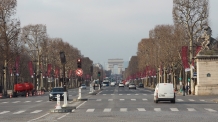Avenue Champs-Élysées
The Avenue des Champs-Élysées is the main street of today’s Paris. It is located in the 8th district of Paris, running from the Place de la Concorde to the Place Charles de Gaulle (historically known as the Place de l’Étoile).
Until the early 17th century, the land where the avenue currently runs was a swampy area in the former course of the River Seine. In the beginning of the 17th century, Marie de Medici ordered to build an alley along the Seine starting from the Tuileries Garden which was then located on the western border of the city. The alley was named the “Cours de la Reine” (Queen’s Drive). After draining the swamps in 1667, André Le Nôtre continued the central alley of the Tuileries Garden into a wide boulevard lined with elms (this is where the Champs-Élysées runs today). The boulevard ended with a crossing at the place of the today’s Place Rond-Point. From there, two other alleys were built, running toward the Cours de la Reine. One of them was known as the Alley of Widows as it was visited by lonely ladies looking for men in the hope of being rewarded. In the beginning of the 18th century, the rectangular area between the alleys was called the “Champs-Élysées” (the Elysian Fields).
In the 1717 Description of Paris, the Champs-Élysées was described as “an extensive space planted with tall trees that form several alleys of different width which are good for taking carriage rides”. It is only in the second half of the 18th century that the alley lying on the main axis of the Tuileries Garden and continued up to the Colline du Roule (the Hill of the Roule, which later became the Place de l’Étoile) was given the name “Champs-Élysées” and began to be built up. The avenue acquired its modern appearance during the Second Empire as part of the Haussmann’s renovation of Paris.
On June 5/16, 1717, Tsar Peter I attended a review of the royal troops which took place in the alleys of the Champs-Élysées. This was described by a witness as follows:
“The Tsar expressed a wish to see the Royal troops. The Regent ordered the gendarmes, light cavalry, musketeers, and the French and Swiss guards to gather on the 16th after lunch. It was chosen to conduct the review in the grand alley of the Champs-Élysées. The French and Swiss guards were drawn up in five lines from the beginning of the alley up to the barrier that separates it from the Roule Alley. The cavalry was drawn up in four lines from the barrier to the l’Étoile. The gendarmes were led by the Prince de Rohan-Soubise and the light cavalry was led by the Duke de Chaulnes and his son. Monsieur d’Artagnan commanded the Grey Musketeers and Monsieur Candillac commanded the Black Musketeers. The Duke du Maine and the Duke de Guiche were on horseback. At half past three, the Tsar was at the beginning of the Champs-Élysées alleys. He and his entourage members were offered royal horses. The Duke d’Orléans was also riding a horse and was surrounded by courtiers. Accompanied by the Regent, the Tsar quickly rode in front of the first line and began to watch the marching exercises of the infantry. However, the clouds of dust raised by carriages, horses and the countless numbers of people entailed inconvenience on the monarch and he had to leave without having seen the marching of the wonderful troops.”
A characterization of the French troops given by Peter I, as purportedly provided by his contemporary, is found in a literary mystification dated the second half of the 18th century: “What I saw was decked-out dolls, not soldiers. They make feints with their guns and their marching is nothing else but dancing.”



